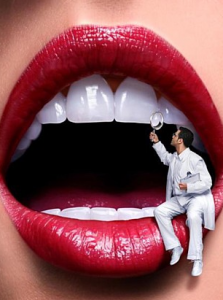Highly hygiene – is not a luxury, but a simple pledge of healthy teeth. You have to do this procedure every 6 months.
If you do not do this procedure all the time, at the necks of the teeth accumulate plaque and appears dark tartar. Such plaque can go under the gum for 3-5 mm.
Removal of dental plaque – is the main procedure in the prevention and control of such diseases as severe gingivitis, caries, periodontal disease and periodontitis…
Plaque – is a waste product of bacteria, but simply put are acids. Due to the release of these acids and the process of decay is caries. The same plaque is a cause of bad breath.
Because our teeth have not completely smooth surface and inaccessible places that they are hard to clean them with the common brush, the plaque can occur even in those people who continuously monitor their teeth.
Scaling is not just a cosmetic procedure, but it is also prevention, it is necessary, in order to prevent subsequent destruction of the teeth and gums.
Dental plaque is allowed to remove by several methods:
- Ultrasound;
- Mechanical (instrumental);
- Scaling plaque with the usage of ultrasonic scaler
The tip of the instrument vibrates at a high frequency (approximately 25000-30000 Hz). Tool creates oscillatory motion, because such movements are flaking different scaling – “stones.” These plaques can be both flexible and rigid. Soft plaque – are the remnants of food that accumulate on the edge of the gum, and even getting under the gum. Such plaques because of the content of minerals in the saliva is converted into solid.
Hard dental plaque – “stones” are the cause of inflammation periodontal tooth ligament, bleeding, pain during chewing and brushing. As a result of the formation of pockets, exposed necks of the teeth, the teeth become movable.
The procedure lasts from half to one and a half hours, depending on the amount of dental plaque.
At first, if it is necessary, you will be asked to do anesthesia. After that, the dentist will remove dental plaque, using ultrasonic scaler. Then polishes teeth using a polishing tip and the brush. This is to ensure that the surface of your teeth have been as smooth as possible. It is difficult to Microbes to attach smooth polished teeth; they will just slide on it.
The last step of this procedure is to cover dental fluoride varnish. This is necessary in order to protect your teeth from subsequent exposure to germs and prevent appearing of tooth decay.
Varnishes that contain fluoride will remove susceptibility, which may occur after professional cleaning, due to the long exposure of the “stone” on the tooth.
Mechanical or instrumental way.
This method is widely used in the presence of periodontal pockets, for removal of subgingival dental plaque. Dental plaque is scraped from the surface of the tooth.

